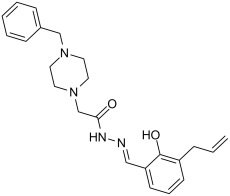This product is for research use only, not for human use. We do not sell to patients.

| Size | Price | Stock |
|---|---|---|
| 250mg | $450 | Check With Us |
| 500mg | $850 | Check With Us |
| 1g | $1275 | Check With Us |
Cat #: V0025 CAS #: 315183-21-2 Purity ≥ 98%
Description: First procaspase-activating compound (PAC-1; VO 100) is a potent small-molecule activator of procaspase-3 that directly catalyzes the maturation of procaspase-3 to the active caspase-3 by inducing the cleavage of procaspase-3 in a time-dependent manner.
Publications Citing InvivoChem Products
Product Promise

- Physicochemical and Storage Information
- Protocol
- Related Biological Data
- Stock Solution Preparation
- Quality Control Documentation
| Molecular Weight (MW) | 392.49 |
|---|---|
| Molecular Formula | C23H28N4O2 |
| CAS No. | 315183-21-2 |
| Storage | -20℃ for 3 years in powder formrrrrrr |
| -80℃ for 2 years in solvent | |
| Solubility In Vitro | DMSO: 78 mg/mL (198.73 mM)rrrrrr |
| Water:<1 mg/mL (slightly soluble or insoluble)rrrrrr | |
| Ethanol: 16 mg/mL (40.76 mM) | |
| Solubility In Vivo | 30% PEG400+0.5% Tween80+5% Propylene glycol: 30mg/mL |
| SMILES Code | O=C(N/N=C/C1=CC=CC(CC=C)=C1O)CN2CCN(CC3=CC=CC=C3)CC2 |
| Synonyms | PAC-1; PAC1; PAC 1; VO-100; VO100; VO 100; procaspase activating compound-1 |
| Protocol | In Vitro | PAC-1 activates procaspase-3 with an EC50 of 2.08 μM. PAC-1 exhibits an enhanced zinc chelating ability (EC50= 7.08 μM). PAC-1 induces leukemia cell death with IC50 of 4.03 μM, which is consistent with the values reported by other investigators. PAC-1 treatment also results in death of other malignant cells in a concentration-dependent manner with IC50s ranging from 4.03 to 53.44μM. The overall mean IC50 in the fifteen malignant cell lines is 0.88 mM for WF-210 and 19.40 μM for PAC-1. In contrast, the sensitivity of the normal human cells (PBL, L-02, HUVEC and MCF 10A) to WF-210 is 2.6-fold lower (mean IC50=412.34 μM) than PAC-1 (mean IC50=158.29 μM). |
|---|---|---|
| In Vivo | As shown in both PAC-1 and WF-210 significantly inhibits the growth of Hep3B tumor xenografts. |
| Solvent volume to be added | Mass (the weight of a compound) | |||
|---|---|---|---|---|
| Mother liquor concentration | 1mg | 5mg | 10mg | 20mg |
| 1mM | 2.5478 mL | 12.7392 mL | 25.4784 mL | 50.9567 mL |
| 5mM | 0.5096 mL | 2.5478 mL | 5.0957 mL | 10.1913 mL |
| 10mM | 0.2548 mL | 1.2739 mL | 2.5478 mL | 5.0957 mL |
| 20mM | 0.1274 mL | 0.6370 mL | 1.2739 mL | 2.5478 mL |
This equation is commonly abbreviated as: C1 V1 = C2 V2
- (1) Please be sure that the solution is clear before the addition of next solvent. Dissolution methods like vortex, ultrasound or warming and heat may be used to aid dissolving.
- (2) Be sure to add the solvent(s) in order.




































